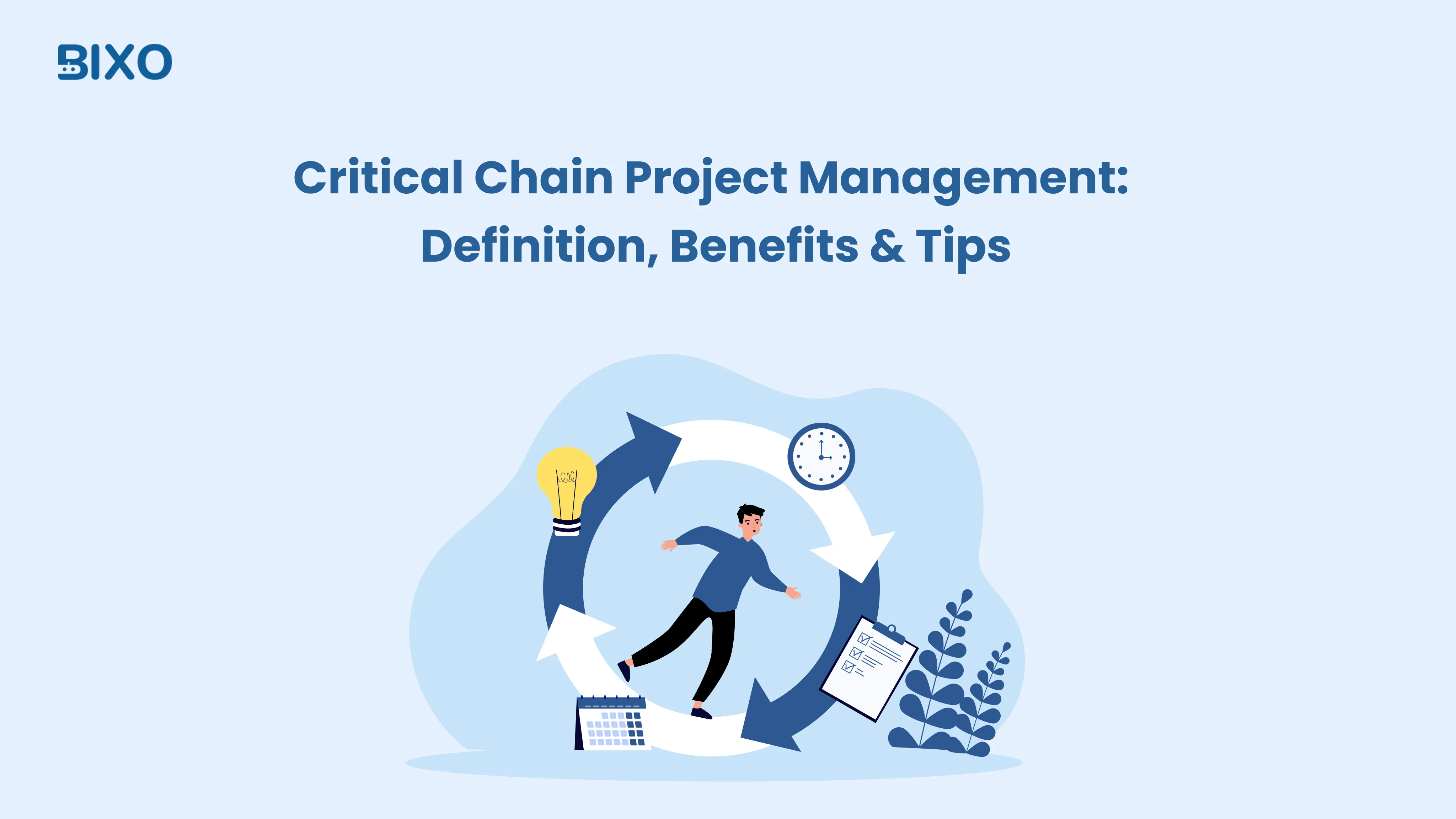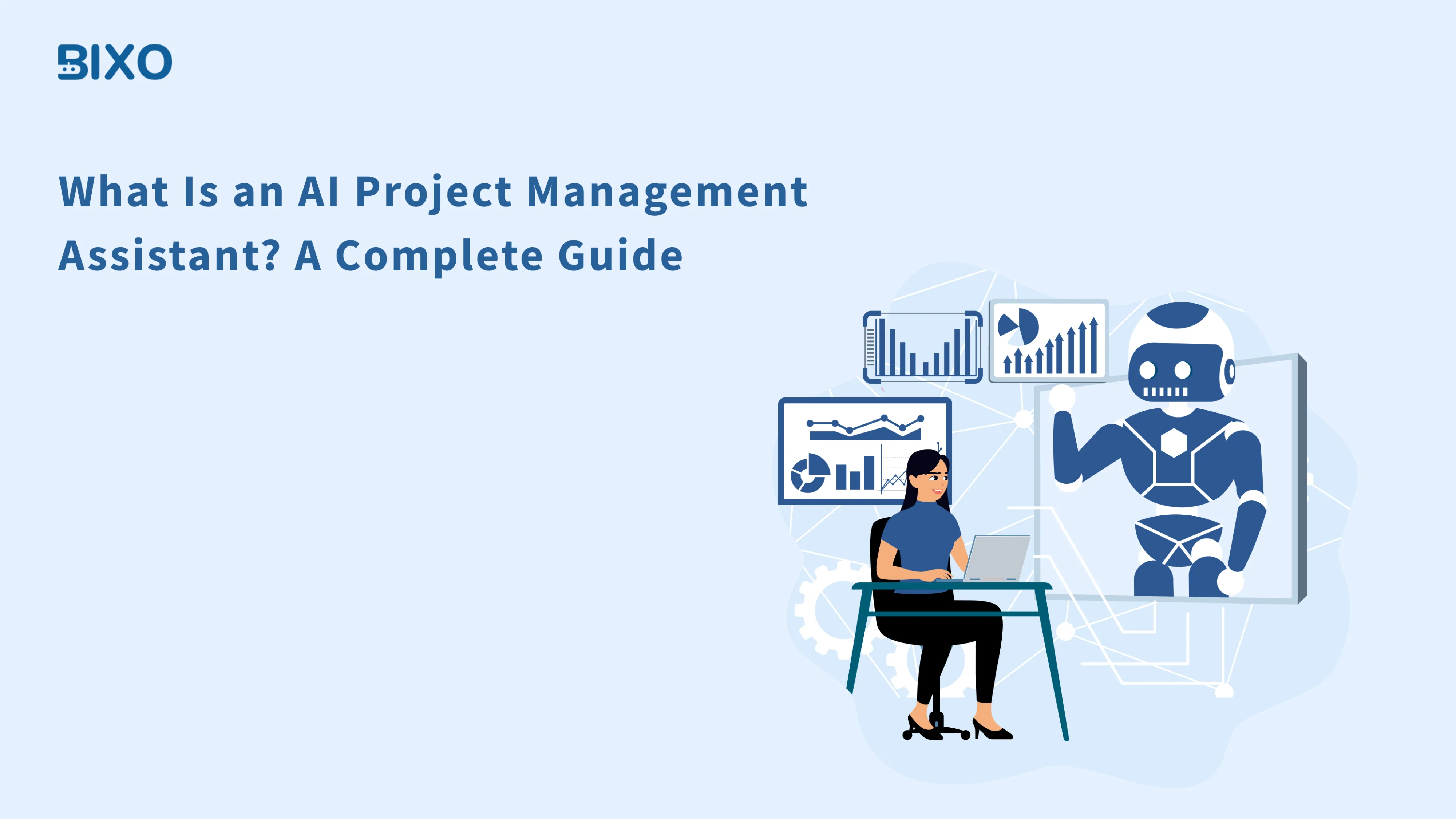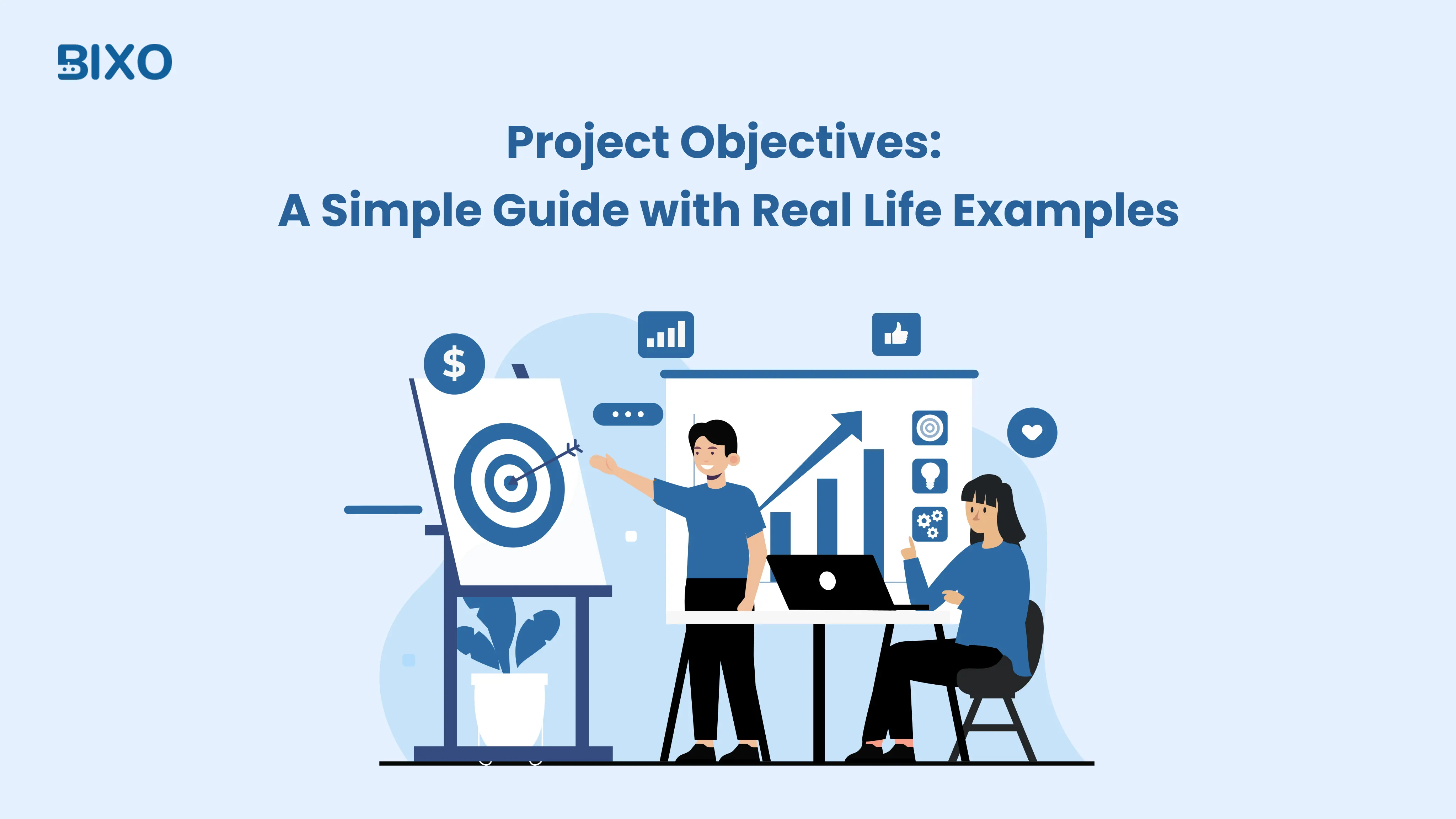
Table of Content
Focus on what matters. BIXO handles the rest!

Planning a project is much easier when your project objectives are clear. They show you what success should look like, help everyone stay on the same page, and make it easier to track progress. Without clear objectives, even a good plan can go off track.
This guide explains what project objectives are, how they're different from other parts of a project, and why they’re important. You’ll also see real project objective examples and learn how to create your own. If you’ve ever wondered what project objectives are or how to set them, then you are in the correct place.
What Are Project Objectives?
Project objectives are the specific results you want to achieve by the end of a project. They clearly state what needs to be done, by when, and to what level of quality. Unlike general project goals, which are broader, objectives break the work into smaller, clear steps that can be measured and tracked. Each one gives a clear target that helps plan tasks and move the project forward.
These objectives usually cover things like deadlines, tasks to complete, or expected results. They’re written in a way that avoids confusion. A good project objective explains what needs to happen, how success will be measured, and when it should be finished. If you look at simple project objective examples, you'll see they focus on the outcome and timing without using vague or unclear words. That’s why they’re a key part of any well- planned project.
Why Project Objectives are Important for Every Successful Project?
Project objectives are important for any successful project. They clarify the work to be done, focus the team's efforts, and specify expectations clearly for all participants. Clear goals help you plan better, stay on track, and get the results you’re aiming for. Without project objectives, well-managed projects can lose focus and fail to deliver on what matters.

Guide the Team
Project objectives help your team know exactly what to do. No one has to guess what’s important because the goals are already clear. This keeps everyone on the same page, avoids confusion, and makes it easier to work together. When the team understands the plan, they don’t waste time and move the project forward with purpose.
Measure Progress
When your objectives are clear and easy to measure, it’s much simpler to see how the project is going. You can tell if tasks are on time, if goals are being reached, and where changes might be needed, without guessing. Instead of unclear updates, you get a clear picture of how close you are to your targets and whether the work is staying on track with your original plan.
Boost Team Motivation
Employees feel more motivated when they clearly understand the goals. Project objectives help connect everyday tasks to the bigger picture. When the team sees progress and knows their work matters, they stay active and involved from beginning to end. And when everyone can imagine what success looks like, it’s easier to stay focused and put in their best effort.
Manage Expectations
Clear objectives set the limits of what the project will deliver. They help everyone involved, including your team and clients, understand what to expect. This avoids confusion and helps prevent last-minute changes or unrealistic requests. When everyone understands the plan from the beginning, it’s easier to give feedback and make decisions as the project moves forward.
Prevent Scope Creep
Clear project objectives help you stay focused on what is most important. When new ideas or requests come up, you can quickly check if they match the original plan. If they don’t, you know when to say no, which helps protect your time and resources. It’s easier to avoid distractions and extra work when your main goals are clearly set from the start.
How Objectives of the Project Different from Other Elements?
When you're running a project, it’s easy to get confused about your objectives with things such as goals, plans, or milestones. They might sound similar, but each one plays a different role. Knowing how they are different makes it easier to plan clearly, avoid mix-ups, and guide your team better.
Project Objectives vs. Project Goals
When you start a project, objectives tell you what needs to be done. They’re clear and specific, so you know exactly what you're working toward. You can check progress, see how things are going, and know when the job is done. Clear project objectives help everyone stay focused and move in the same direction.
Goals are simpler and broader. They explain the main reason for doing the project or what they hope to achieve. You don’t measure goals with exact numbers. They just give you a clear direction and help you understand why the project is being done.
Example:
Project Objective: Raise the customer support rating from 3.8 to 4.5 in 90 days by starting a new training program.
Project Goal: Make customers happier.
Project Objectives vs. Business Objectives
Project objectives are short-term goals that explain what a project needs to do and by when. They help you check progress, manage the work, and get clear results. These objectives keep your team on track and help the project to support the company’s main goals in a useful way.
Business objectives are long-term goals for your whole company. They help you decide how the company should grow, improve, and move forward. These goals often need the work of many teams and aren’t connected to just one project. Your project objectives can help reach these bigger goals, but they don’t replace them.
Example:
Project Objective: Launch a localised e-commerce website for Canada within the next 6 months.
Business Objective: Expand into the North American market over the next 2 years.
Project Objectives vs. Project Plan
Project objectives are about what you want to get done and how you’ll know it’s working. They focus on results, like fixing mistakes, getting more people involved, or finishing the work on time.
A project plan explains how you’ll reach your goals. It lists the tasks, steps, tools, and project schedule you’ll use to get the job done. If your objectives aren’t clear, the plan can get messy and confusing. And if you don’t have a plan, your goals are hard to reach.
Example:
Project Objective: Reduce website bounce rate by 20% in 3 months.
Project : Redesign the homepage layout, improve mobile responsiveness, add live chat, and run A/B tests over 12 weeks.
Project Objectives vs. Project Milestones
Project objectives tell you what you want to get done by the end of the project. They focus on the final result, like completing a product, making a system better, or hitting a goal by a certain date. These objectives guide the whole project and help you know if it was successful.
Project Milestones are steps you reach during the project. They help you see how things are going, stay on track, and make sure everything is moving forward. Milestones show your progress, but the objective is the final goal you're working toward.
Example:
Project Objective: Develop and launch a new HR software module by the end of Q4.
Project Milestone: Finish the user interface design by August 31.
Project Objectives vs. Project Deliverables
Project objectives are what you want to get done by the time the project is over. They focus on the main goal, like fixing an issue, making something better, or hitting a target. These objectives help you stay on track and check if the project worked out the way you planned.
Project Deliverables are the things you make or build during the project to help you reach your goals. It could be a report, a new feature, a software tool, or any finished item your project is supposed to deliver.
Here’s an easy way to understand it:
- The objective is the result you want.
- The deliverable is what you create to make that result happen.
Example:
Project Objective: Make team communication better by using a simpler messaging system.
Project Deliverable: A working Slack setup with team chats and connected apps.
What Are the Main Project Management Objectives?
When you set project objectives, it’s easier to group them into different types. Each kind has a clear purpose and helps your project move forward. Here’s a quick look at the main areas to focus on so nothing gets missed.

1. Performance Objectives
Performance objectives focus on how well the project meets its goals. They set clear targets for things like how fast work gets done, how efficient the process is, and the quality of the results. These objectives help keep everyone on track to finish tasks on time and work productively. Basically, they show if the project is going as planned and delivering good results.
2. Business Objectives
Business objectives connect your project to the company’s bigger goals. They focus on what the project should do for the business, like getting more customers, reaching new markets, or making customers happier. When you set these objectives clearly, you make sure the project supports the company’s plan and brings real benefits.
3. Effectiveness Objectives
Effectiveness objectives concentrate on impact and the outcome of your project. These objectives don’t just look at activity, but at whether the results of the project actually address the problem or meet user needs. You’d like to measure how well the project’s deliverables are working in real life and if they really make long-term change or improvement, as you wanted.
4. Financial Objectives
Financial objectives are about managing money in your project. This includes setting a budget, keeping costs under control, and making sure the project gives back more value than it spends. These goals help you track where the money goes and make sure the project is worth the investment. They’re key to knowing if your project is financially successful or not.
5. Regulatory Objectives
Regulatory objectives guide your project to comply with laws, regulations, and industry standards. This is especially important for projects in areas such as healthcare, finance, and manufacturing. By developing regulatory objectives early in the project, you'll be able to avoid compliance risks, penalty fines, or delays for not meeting required guidelines.
6. Technical Objectives
Technical objectives specify the technology or systems that your project will use or deliver. This could be software functionality, system integration, technical performance targets, and guidelines. These objectives allow you to clearly define the technical aspects of your project so everyone understands the expected outcomes in clear, achievable, and aligned objectives.
7. Quality Objectives
Quality objectives emphasise the standards your project's deliverables must meet. Consider it as providing work without defects and meeting customer expectations. Setting quality objectives allows you to articulate the definition of success, which is the most important step for continually improving and decreasing errors throughout project deliverables.
How to Set Clear and Effective Project Management Objectives?
Setting your project objectives right from the beginning is really important. They’re not just something you write down and forget. They help you build a solid plan, make better decisions, keep your team on the same page, and understand what success looks like. Strong project objectives keep you focused, especially when things don’t go as planned, and they give everyone a clear direction to follow.
Here’s how you can set project objectives that are clear, practical, and actually work.
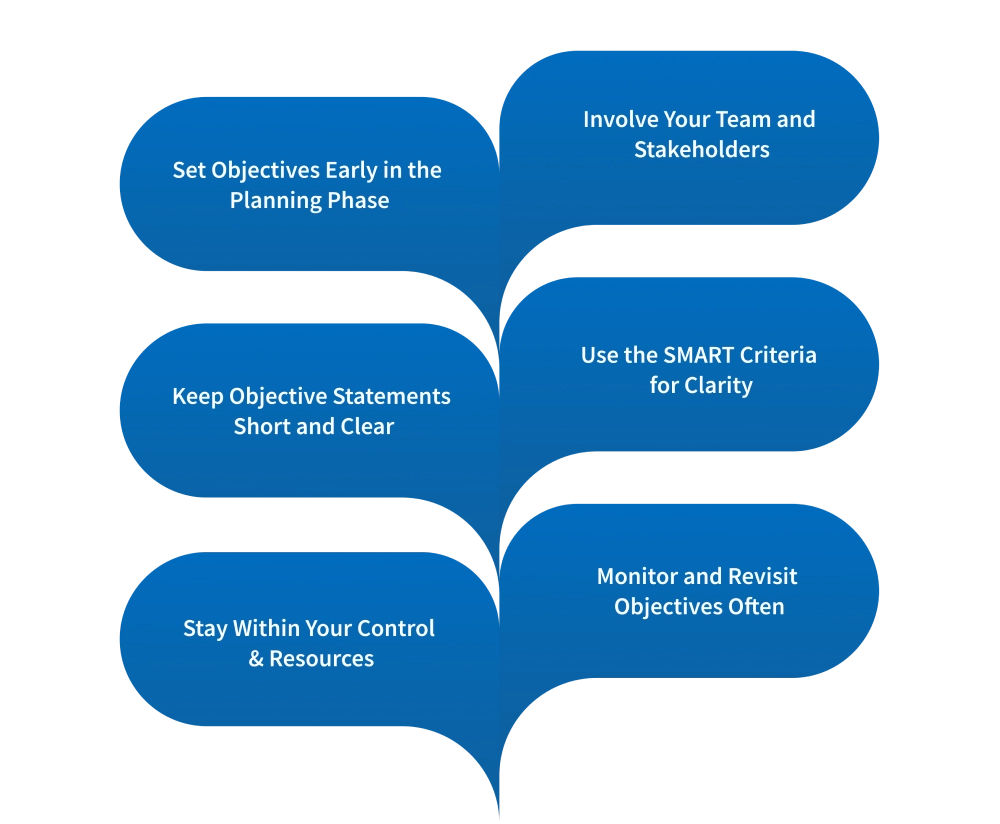
Set Objectives Early in the Planning Phase
Don’t wait until the project has already started to decide what your goals are. Set your project objectives at the very beginning, during the planning stage. This gives you a clear base to build the rest of the project, like your schedule, budget, and tasks. When you set objectives early, you avoid confusion and help everyone stay on the same page from day one. It makes the whole process smoother and more organised.
Involve Your Team and Stakeholders
Don’t try to set project objectives all by yourself. Talk to the people who will be working on the project and those who will be affected by the outcome. When you involve them early, the objectives become more practical and easier for everyone to understand and follow. It also helps build support from the start, which can avoid issues later. It’s not just about getting agreement; it’s about making sure the goals make sense for everyone.
Keep Objective Statements Short and Clear
If your project objectives sound too long or complicated, they won’t be useful. Keep them simple, clear, and straight to the point. A good objective clearly says what needs to be done and why it’s important. If someone can’t understand it right away, it needs to be clearer. Good objectives don’t need extra explanation. They should make the next steps obvious.
Use the SMART Criteria for Clarity
This is still important. SMART means your objectives should be Specific, Measurable, Achievable, Relevant, and have a Time limit. It’s a simple way to check if your goals make sense. Saying “launch the new system soon” is too vague. Instead, saying “Finish user testing and release version 2.0 by November 15” gives you a clear goal to work toward. Using SMART helps keep your project objectives real and focused.
Stay Within Your Control & Resources
Your objectives should be realistic. That means they need to match the time, money, and people you actually have, not what you wish you had. It’s okay to aim high, but don’t set goals that depend on things you can’t control. The best project objectives are ones you can achieve with the resources available. If not, you and your team might struggle to succeed.
Monitor and Revisit Objectives Often
Setting your project objectives is just the first step. As the project moves forward, you need to check often to see if those objectives still make sense. Priorities can change, new challenges might come up, and things may not go as planned. By reviewing and adjusting your objectives when needed, you keep your project on the right track. Don’t set objectives once and forget about them. Treat them like a part of your plan that needs regular attention.
What Are the Key Benefits of Project Objectives?
Before jumping into a project, it’s good to be clear on what project objectives are and why they matter. When your team knows the objectives of the project, everyone can stay on the same page and work with purpose. These goals also make it easier to plan, track progress, and make decisions along the way.
These are just a few reasons why setting clear project objectives from the start really helps.
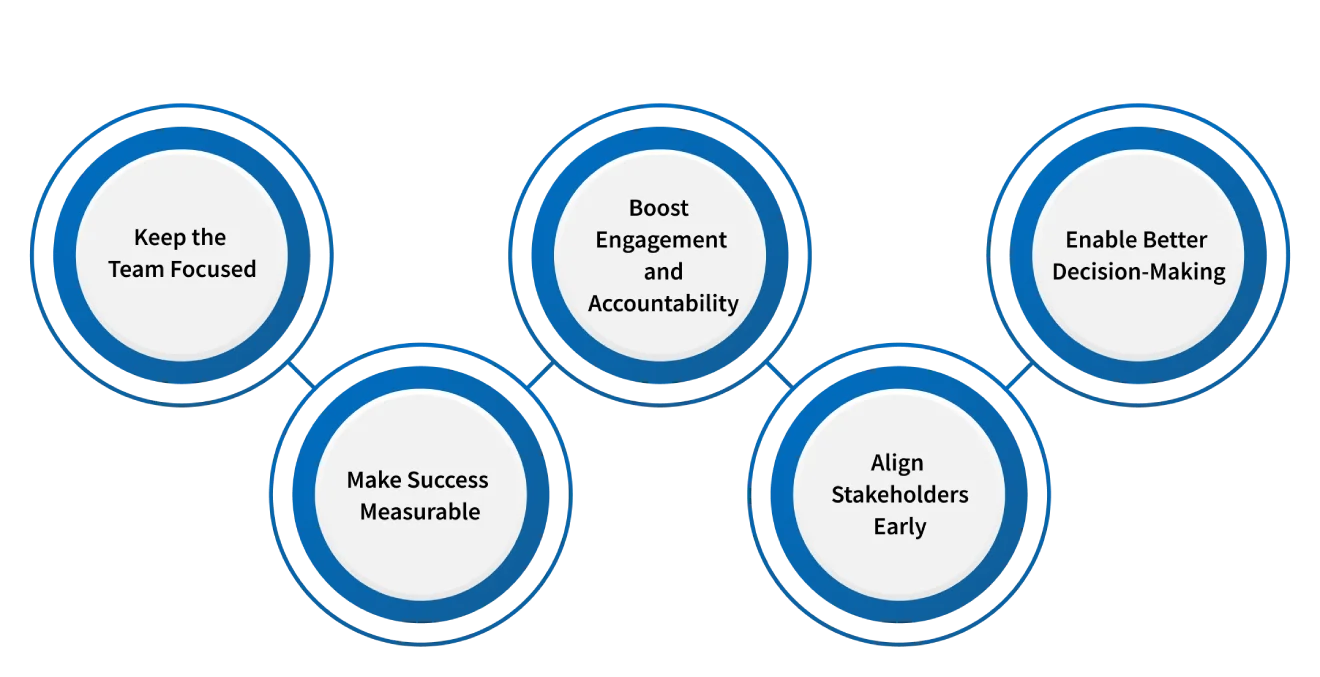
Keep the Team Focused
When your team has a clear understanding of project specifications, it becomes clearer to stay on the path. No second-guessing, no multitasking, just clear direction. Instead of trying to juggle too many tasks at once, everyone knows what matters most and works toward the same goal.
Make Success Measurable
You can’t improve what you don’t keep track of. Having clear objectives of the project means you can see how things are going as you move forward. Project management objective makes it easy to know when you should stay on track and when it is necessary to make adjustments, whether it is deadlines, costs, or achievements of milestones.
Boost Engagement and Accountability
When people know what they’re working toward, they naturally feel more involved. Ownership and engagement are achieved through clear project objectives. When people know how their work benefits the overall goal, it motivates them more. And when things go off track, it's easier to spot gaps and get back on course.
Align Stakeholders Early
Everyone, from team leads to clients, needs to be on the same page. Clear project objectives will enable you to set expectations early and eliminate misunderstandings. Demonstrating a couple of examples of their project objectives can help the stakeholders see what success means and also limit back-and-forth during the reviews.
Enable Better Decision-Making
When unexpected issues come up, your project management objectives act like a guide. They help you make smart choices that support the bigger goal. Whether it’s changing priorities or reallocating resources, knowing the objectives of the project makes it easier to decide what matters most and where to utilise your time and energy.
What Are Some Real-Life Project Objective Examples?
The easiest way to understand project objectives is by looking at real examples. These are some basic ones in marketing, operations, and product development.
Marketing Objective Example
Consider that your team is preparing to introduce a new product. You want to make more people aware of it and to access your website.
A definite marketing objective could be:
“Increase the number of visitors to our site by 25% within a 3-month period using social media advertising.”
This provides the team with an objective, a deadline, and a means of tracking progress. Everyone knows what they’re working on and how it contributes to the launch.
Operations Objective Example
In operations, the goal is to make things run faster and smoothly. Let’s say your order processing is taking too long and causing delays. A strong objective could be:
“Cut down order processing time from 3 days to 1 day by the end of this quarter.”
This provides the operation manager team with a definite point of focus; they might automate some of the process or change their ordering processing layout. It guides all towards improved speed and customer satisfaction.
Product Development Objective Example
For example, say your product team is making a new brand mobile app. They need a goal that helps them stay focused and meet deadlines. A good example might be:
“Develop a working prototype of the application by October 15th under a basic feature set of the application, which includes the login, dashboard, and alerts.”
This helps the team know exactly what needs to be done first, without trying to do everything at once. It also helps the managers to easily review and provide feedback at any stage.
Which Tools Can Help You Define Better Project Objectives?
Picking the right tools makes it much easier to set clear project objectives and actually stick to them. It’s not just about writing goals on paper. It’s about making sure the right work gets done on time, and everyone knows what’s happening without needing constant reminders or meetings. These tools help you turn unclear ideas into clear and trackable goals.
BIXO for Defining Objectives Clearly
If you often feel like you're spending more time asking for updates than actually managing your project, BIXO fixes that. Once you set the work, BIXO acts like your AI task manager that talks to your team for you. It checks how things are going, asks if anything is blocking progress, reminds them about deadlines, and keeps you updated without you having to keep asking.
You’ll get simple summaries, live updates, and helpful notifications so you always know what’s happening, from daily work to deadline warnings. If something goes wrong, BIXO tells you and only brings problems to you when needed. This means you can handle bigger teams without spending all your time in meetings or chasing updates.
Instead of managing every little detail yourself, BIXO helps you stay focused on your project goals. It saves time, improves team productivity, and lets you spend more energy on planning instead of follow-ups.
SWOT Analysis
If you want to set project objectives that actually work, you first need to know what could help or slow things down. That’s where SWOT analysis helps. It looks at your strengths, weaknesses, opportunities, and threats so you can see what’s possible and what to avoid.
This helps you create clearer and more realistic project plans. Instead of setting unclear goals, you’ll define objectives that match what your team can actually do. It also helps you find risks early, so you can plan better and avoid problems later on.
Mind Mapping Tools
Sometimes, the hardest part of setting clear project objectives is figuring out what truly matters. Mind mapping tools help by giving you a simple, visual way to look at all your ideas, tasks, and priorities. You can start with a main goal in the centre, then branch out related points, break them into smaller steps, and spot anything that’s missing.
This makes your project objectives easier to understand and more organised. These tools are especially helpful when you need to plan both short-term tasks and long-term goals that grow and change over time.
Stakeholder Feedback Sessions
You don’t set good project objectives in isolation. Objectives should reflect not just the work, but what matters to the people who rely on the outcome. Holding focused feedback sessions with your stakeholders, whether they’re clients, partners, or internal teams, helps you align your goals with real expectations.
These sessions help prevent mismatched priorities, shifting requirements, or late-stage surprises. Plus, when everyone feels heard early on, they're more likely to stay committed to the plan.
Confluence for Team Collaboration
Once your project objectives are set, you need a place to keep them safe, easy to find, and easy to update. That’s where Confluence comes in. It gives your team one shared space where you can store everything, from starting goals to the latest changes.
It’s more than just a place to take notes. You can break big goals into smaller tasks, track what depends on what, and connect updates directly to your objectives. This helps your team stay on track, avoid repeating work, and stay clear on what success looks like.
If you want to create clear project management objectives, avoid confusion, and keep your team on the same page from the start, these tools can help. Whether you’re just beginning or handling big projects with many teams, each tool offers something valuable to make your work easier.
Conclusion
Clear project objectives help keep your project moving in the right direction and make sure everyone knows what to focus on. When you’re sure about what you want to achieve and how to check your progress, it’s easier to handle tasks and make good decisions. Knowing what project objectives are and how they fit into your overall plan stops confusion and keeps your goals clear. By setting simple, useful objectives and looking at real examples, you’ll help your team work better and make sure your project gets done the way you want.
FAQs
They help everyone know what to focus on. With clear objectives, it’s easier to see how the project is going, avoid mix-ups, and stay on time. Without them, it’s easy to get off track and spend time on things that don’t really help.
Goals are general ideas about what you want to do. Objectives are clear, measurable steps that explain how and when you’ll reach those goals. Objectives break the work into smaller parts that you can follow and check.
If you set objectives once and don’t look at them again, they can get out of date when things change. Checking them regularly helps you update the plan, handle new problems, and stay focused on what matters most.
Talk to everyone affected by the project early and often. This makes sure the objectives are clear, practical, and agreed on. It also helps everyone stay committed and work together toward the project’s success.
Get a demo of BIXO
Recommended Blogs
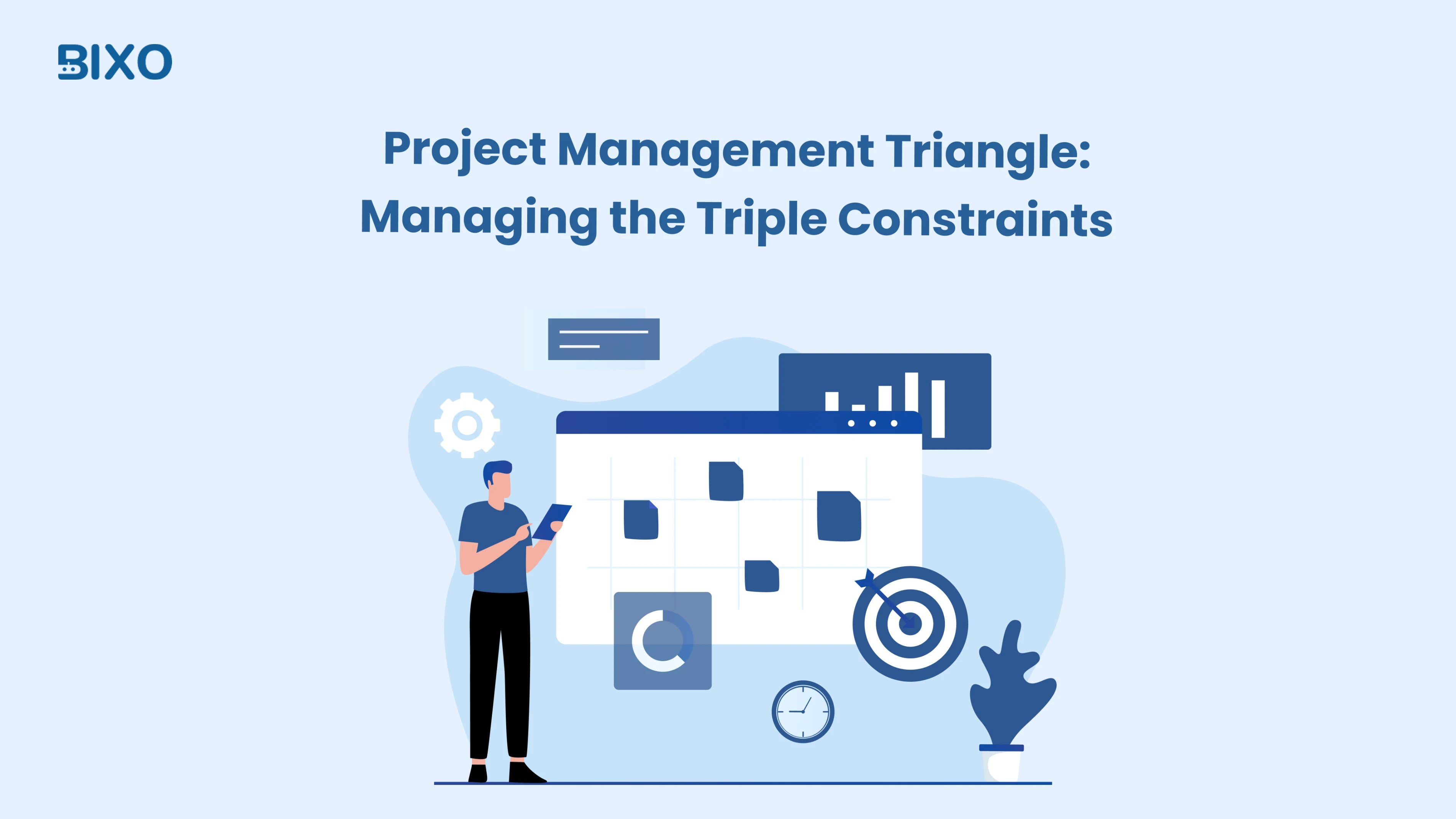
Project Management Triangle: Managing the Triple Constraints
Master the project management triangle by balancing scope, cost, and time with simple strategies that drive successful outcomes every time.
 Jahnavi Chintakrindhi |
Jahnavi Chintakrindhi |
 Oct 13, 2025
Oct 13, 2025

